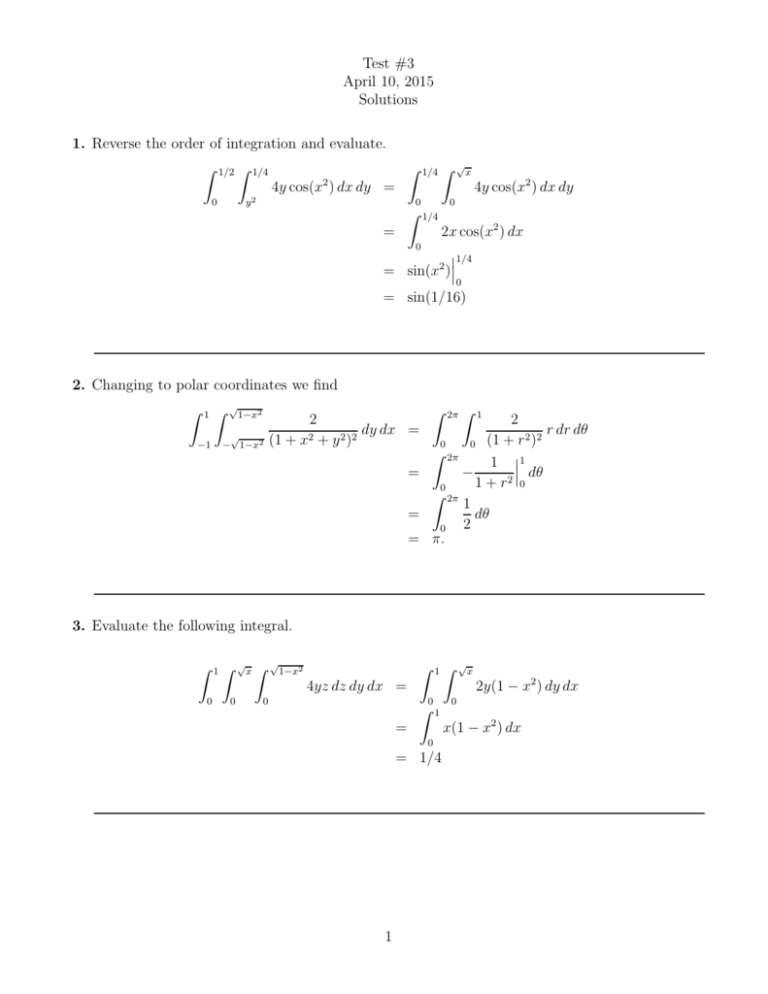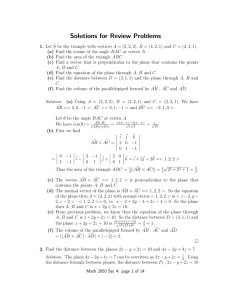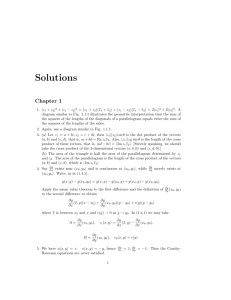Test #3 April 10, 2015 Solutions 1. Reverse the order of integration
advertisement

Test #3 April 10, 2015 Solutions 1. Reverse the order of integration and evaluate. Z 1/2 0 Z 1/4 2 4y cos(x ) dx dy = y2 Z 1/4 Z 1/4 Z √ x 4y cos(x2 ) dx dy 0 0 2x cos(x2 ) dx 0 1/4 = sin(x2 ) = 0 = sin(1/16) 2. Changing to polar coordinates we find Z 1 −1 Z √ 1−x2 2 √ − 1−x2 (1 + x2 + y 2 )2 2π 1 2 r dr dθ 2 2 0 0 (1 + r ) Z 2π 1 1 = − dθ 1 + r2 0 0 Z 2π 1 = dθ 2 0 = π. Z dy dx = Z 3. Evaluate the following integral. Z 0 1 Z √ 0 x Z √ 1−x2 1 4yz dz dy dx = Z 1 = Z 0 0 0 = 1/4 1 Z √ x 2y(1 − x2 ) dy dx 0 x(1 − x2 ) dx 4. Verify Green’s theorem in flux form for the region in the first quadrant bounded by x = 0, y = x and the unit circle and the vector field given by F = hx, yi. Solution. We have to evaluate Z π/2 Z π/4 1 ∇ · h−y, xi r dr dθ = 0 I hx, yi · n ds. The left side is π/4. The right side has three pieces. • On the line y = x, x(t) = t = y(t), 0 ≤ t ≤ 1, r = ht, ti, r′ = h1, 1i, n = h1, −1i. Thus Z Z 1 F · n ds = ht, ti · h1, −1i dt = 0. 0 • On the curve portion x(t) = cos t, y(t) = sin t, π/4 ≤ t ≤ π/2. So n = hcos t, sin ti and the flux on this portion is Z Z π/2 F · n ds = hcos t, sin ti · hcos t, sin ti dt = π/4. π/4 • On the line x = 0, x(t) = 0, y(t) = 1 − t, 0 ≤ t ≤ 1, r = h0, 1 − ti, r′ = h0, −1i, n = h−1, 0i. Thus Z Z 1 F · n ds = h0, 1 − ti · h−1, 0i dt = 0. 0 The sum is π/4 as expected. 5. Verify Green’s theorem in circulation form for the region in the first quadrant bounded by x = 0, y = x and the unit circle and the vector field given by F = h−y, xi. Solution. We have to evaluate Z π/2 Z π/4 1 ∇ × hx, yi r dr dθ = 0 I hx, yi · T ds. The left side is π/4. The right side has three pieces as in the previous problem. • As above, on y = x, r′ = h1, 1i. Thus Z Z 1 ′ F · r dt = h−t, ti · h1, 1i dt = 0. 0 • On the curve portion x(t) = cos t, y(t) = sin t, π/4 ≤ t ≤ π/2. Z Z π/2 ′ F · r dt = h− sin t, cos ti · h− sin t, cos ti dt = π/4. π/4 • On the line x = 0, x(t) = 0, y(t) = 1 − t, 0 ≤ t ≤ 1, r′ = h0, −1i. Thus Z Z 1 ′ F · r dt = ht − 1, 0i · h0, −1i dt = 0. 0 The sum is π/4 as expected. 2










